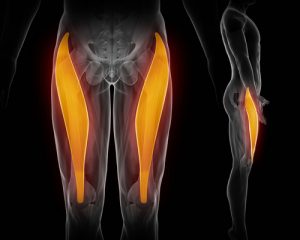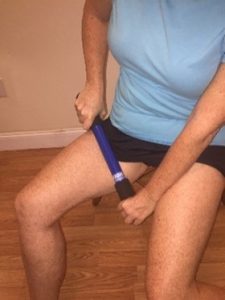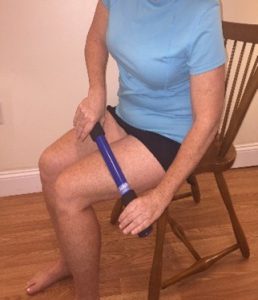How Can A Thigh Muscle Cause Groin Pain?
Author: Julie Donnelly, LMT –The Pain Relief Expert
Editor: Dr. Steve Chaney
May Is A Beautiful Time Of Year
 It’s MAY!! Bring on the flowers that came from the April showers!
It’s MAY!! Bring on the flowers that came from the April showers!
Of course, here in Florida we have flowers all year, so it’s our friends to the north that are enjoying a glorious array of color during this month.
In some ways, life is beginning to slow down for us. With most of the snowbirds gone, driving is easier, the stores are less crowded, and we can park at the beach. The weather is still beautiful so we can still go outside to ride a bike, jog, or play the sports we enjoy.
This Month’s Treatment – The Rectus Femoris Muscle

Your Rectus Femoris muscle is one of the four quadriceps muscles of your thigh. It is the only one of the quadriceps that originates on the tip of your pelvis. When your “quads” contract you straighten your leg.
I’ve written several times about the domino-effect of a string of muscles that cause low back pain, hamstring tension, sciatica, and hip/knee pain. I call the entire treatment the Julstro Protocol. I’ve even written a book titled The 15 Minute Back Pain Solution that explains the whole thing. This time I would like to talk about how the rectus femoris muscle can cause groin pain.
How Can A Thigh Muscle Cause Groin Pain?
It’s a bit complicated unless we go through the entire cycle of muscles involved in the Julstro Protocol, but that would be redundant. As a quick refresher, your psoas muscle (anterior side of your lumbar vertebrae) and your iliacus muscle (on the inside of your pelvis bones) both insert into the inside of your thigh bone. When they are strained (usually from sitting for long periods of time – including cyclists who ride for hours, or when you drive a car long distances) they shorten and rotate your pelvis forward and down.
This forward rotation causes your rectus femoris to be too long to do the job of straightening your leg, so the body ties a knot (a spasm/trigger point) on the outside of your thigh, right where your middle finger touches when you have your arms relaxed at your side. This knot then holds your pelvis down in the front, and your pelvis rotates – down in the front and up in the back.
This is where the groin problem comes in. Your pubic bone/groin is being moved backward during this rotation. The muscles of your inner thigh all originate on your pubic bone, but they are now being overstretched! As a result, they are putting stress on your pubic bone.
Just like pulling on your hair will hurt your scalp, the muscle pulling on the bone will hurt the bone, in this case, the pubic bone. You end up with groin pain!
I’ve had people think they had a serious condition (one man was told he had the beginning of prostrate cancer!!) when all that is happening is a muscle strain. And one that is simple to fix.
We aren’t going through the entire Julstro Protocol, even though that is exactly what I’d do if you came in to the office. If you’re interested, the entire program is in the book. However, I do want to show you how to do the treatment for your rectus femoris.
Relief From Groin Pain
Treating Your Rectus Femoris
Sit in a chair and use either a 12”x1” piece of PVC pipe or a rolling pin (don’t let it roll). Starting at the top of your thigh, slide the pipe down to your knee as shown in the pictures below. Rolling will prevent you from going deep enough into the muscle, so just slide.
Do your entire thigh, outside-front-inside. You will likely find big “speed bumps” all along the muscles. The picture on the right is treating your rectus femoris, and the picture on the left is treating your adductor muscles which all originate on your pubic bone. With the adductors, you may find a painful point closer to your inner knee where several muscles all join together to stabilize your knee joint.
Press deeply, but always stay within your pain tolerance level – it should “hurt so good,” but never be severe pain.
I always suggest that you do three passes down each line of muscles, and then go back and focus some direct attention on each bump (spasm) to bring blood into the area and release the knotted muscle fibers.
Wishing you well,
Julie Donnelly
These statements have not been evaluated by the Food and Drug Administration. This information is not intended to diagnose, treat, cure, or prevent any disease.


